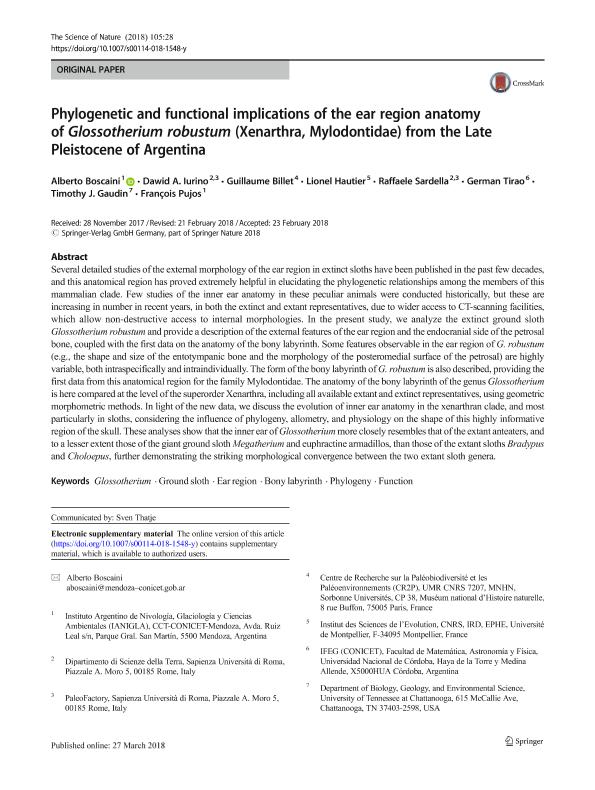Artículo
Phylogenetic and functional implications of the ear region anatomy of Glossotherium robustum (Xenarthra, Mylodontidae) from the Late Pleistocene of Argentina
Boscaini, Alberto ; Iurino, Dawid A.; Billet, Guillaume; Hautier, Lionel; Sardella, Raffaele; Tirao, German Alfredo
; Iurino, Dawid A.; Billet, Guillaume; Hautier, Lionel; Sardella, Raffaele; Tirao, German Alfredo ; Gaudin, Timothy; Pujos, François Roger Francis
; Gaudin, Timothy; Pujos, François Roger Francis
 ; Iurino, Dawid A.; Billet, Guillaume; Hautier, Lionel; Sardella, Raffaele; Tirao, German Alfredo
; Iurino, Dawid A.; Billet, Guillaume; Hautier, Lionel; Sardella, Raffaele; Tirao, German Alfredo ; Gaudin, Timothy; Pujos, François Roger Francis
; Gaudin, Timothy; Pujos, François Roger Francis
Fecha de publicación:
04/2018
Editorial:
Springer
Revista:
Naturwissenschaften
ISSN:
0028-1042
e-ISSN:
1432-1904
Idioma:
Inglés
Tipo de recurso:
Artículo publicado
Clasificación temática:
Resumen
Several detailed studies of the external morphology of the ear region in extinct sloths have been published in the past few decades, and this anatomical region has proved extremely helpful in elucidating the phylogenetic relationships among the members of this mammalian clade. Few studies of the inner ear anatomy in these peculiar animals were conducted historically, but these are increasing in number in recent years, in both the extinct and extant representatives, due to wider access to CT-scanning facilities, which allow non-destructive access to internal morphologies. In the present study, we analyze the extinct ground sloth Glossotherium robustum and provide a description of the external features of the ear region and the endocranial side of the petrosal bone, coupled with the first data on the anatomy of the bony labyrinth. Some features observable in the ear region of G. robustum (e.g., the shape and size of the entotympanic bone and the morphology of the posteromedial surface of the petrosal) are highly variable, both intraspecifically and intraindividually. The form of the bony labyrinth of G. robustum is also described, providing the first data from this anatomical region for the family Mylodontidae. The anatomy of the bony labyrinth of the genus Glossotherium is here compared at the level of the superorder Xenarthra, including all available extant and extinct representatives, using geometric morphometric methods. In light of the new data, we discuss the evolution of inner ear anatomy in the xenarthran clade, and most particularly in sloths, considering the influence of phylogeny, allometry, and physiology on the shape of this highly informative region of the skull. These analyses show that the inner ear of Glossotherium more closely resembles that of the extant anteaters, and to a lesser extent those of the giant ground sloth Megatherium and euphractine armadillos, than those of the extant sloths Bradypus and Choloepus, further demonstrating the striking morphological convergence between the two extant sloth genera.
Palabras clave:
BONY LABYRINTH
,
EAR REGION
,
FUNCTION
,
GLOSSOTHERIUM
,
GROUND SLOTH
,
PHYLOGENY
Archivos asociados
Licencia
Identificadores
Colecciones
Articulos(IANIGLA)
Articulos de INST. ARG. DE NIVOLOGIA, GLACIOLOGIA Y CS. AMBIENT
Articulos de INST. ARG. DE NIVOLOGIA, GLACIOLOGIA Y CS. AMBIENT
Articulos(IFEG)
Articulos de INST.DE FISICA ENRIQUE GAVIOLA
Articulos de INST.DE FISICA ENRIQUE GAVIOLA
Citación
Boscaini, Alberto; Iurino, Dawid A.; Billet, Guillaume; Hautier, Lionel; Sardella, Raffaele; et al.; Phylogenetic and functional implications of the ear region anatomy of Glossotherium robustum (Xenarthra, Mylodontidae) from the Late Pleistocene of Argentina; Springer; Naturwissenschaften; 105; 3-4; 4-2018; 1-18
Compartir
Altmétricas



